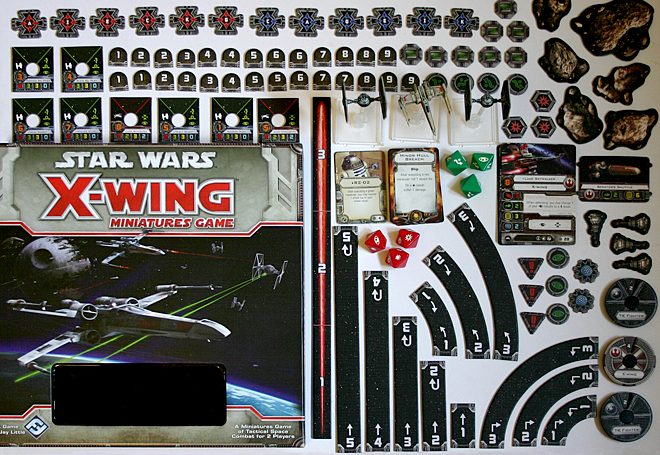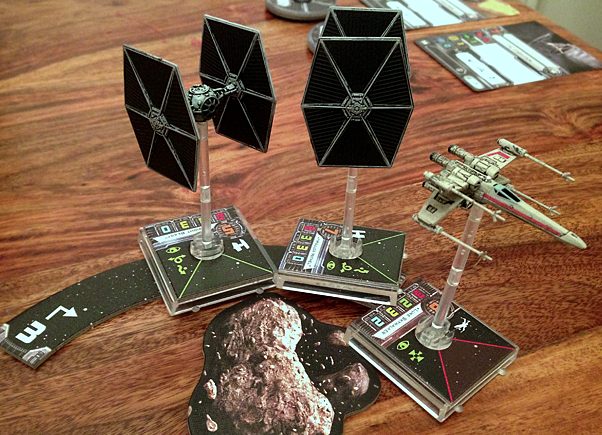
The Star Wars X-Wing Miniatures Game brings space battles between the Galactic Empire and the Rebels to your tabletop by allowing you to fly your favorite ships from the Stars Wars saga into battle. I had never played a miniatures game before and was looking forward to trying out a whole new style of game-play in one of my childhood fictional universes.
On first impressions X-Wing Miniatures is a beautiful game, the three models included in the base pack (two TIE Fighters and an X-Wing) are meticulously detailed and painted, there’s even a tiny silver R2 unit sat in the X-Wing. In fact the only negative thing about the models are how incredibly fragile they feel; the X-Wing’s laser cannons are just 1mm in diameter and the TIE Fighter’s wings are also just 1mm thick. This is not a game for children or the ham-fisted. The chipboard pieces used to play are also excellent quality and thick so there is little risk of damage.
The game is played in an assigned space on the table of approximately two feet square, although it is up to both players to determine the game space for each game and exact measurements are not required. Rounds are played through a sequence of four phases:
- Planning
- Activation
- Combat
- End
Players do not take turns, instead the order of play during each phase is determined the pilot skill of each ship.
During the planning phase, players secretly assign a maneuver to each of their ships using ship-specific dials that show only those maneuvers that the ship is capable of performing. Once each ship’s dial has been assigned the activation phase begins with ships moving in ascending order of their pilot’s skill. Maneuvers are performed using chipboard pieces that correspond to the dial symbols, the correct piece is placed directly in front of the ship on the table and the ship then moves to the opposite end, ships that accidentally fly out of the agreed game space are considered lost so it is important to be aware of the arc and distance of each maneuver. Every maneuver has a difficulty level of green (easy), white (normal), or red (hard) that relates to the level of physical stress placed on the pilot. Red maneuvers create pilot stress; when a pilot is stressed he or she cannot complete more red maneuvers or perform actions until they have performed a green maneuver. Actions can be performed by each non-stressed ship at the end of his or her maneuver and different actions are available to different ships. Actions include performing a barrel roll which moves the ship left or right whilst maintaining its direction of travel, focusing, evading, or acquiring a target lock. Other than barrel rolls, these actions increase the likelihood of hitting targets or evading enemy fire during combat, however each ship can only choose and spend one action during each round and so must choose the best course of action, often without knowing where other ships will be located when combat begins.

Once each ship has maneuvered into its new position, combat begins. Each ship may attack one other ship providing it is within range (calculated with the highly technical use of a range ruler) in descending order of pilot skill. Combat is completed through dice rolls using special green and red d8 dice. Each ship has assigned primary weapon value and agility value, the former corresponds to the number of attack dice which can be rolled to attack and the latter to the number of defense dice rolled when under fire. Damage rolled can be normal or critical (which has additional effects such as blinding the pilot, doubling damage received and reducing agility) and defense dice roll evade symbols which allow for escape. Both types of dice feature focus symbols which can be converted into additional damage or evade symbols providing the ship chose the focus action during the activation phase. Once any dice roll modifications due to actions have taken place, combat occurs with evade symbols canceling out damage, if any damage remains then the ship is hit. Shields are damaged first and once they are destroyed, hull damage begins. A ship is lost when it has received an amount of damage equal to or higher than the ship’s hull value. At the end of combat which each ship has fired, any remaining evade or focus token are removed from play and a new round begins in the planning phase, rounds continue until all the ships from one faction are destroyed.

As well as the standard game detailed above, the base game rule book includes three of set-play missions which take place within the original trilogy. These include the rebels defending a number of holonet satellites until their transmissions can be secured, the Imperials attempting to destroy a damaged ship which is seeking refuge within an asteroid field, and a political escort mission in which the rebels must protect a rebel senator’s shuttle as it crosses the game space. These missions really add to the feel of the game as they add an additional level of storytelling to the experience, a lot of fans have been creating and sharing their own missions online as well so there are now plenty to choose from. The rule book also includes the detailed rules for advanced play which includes squad building, additional weapons, the use of astromech droids, and ship upgrades. Once you have the basics of gameplay down there is a lot of scope for change.
One final component that will change the game is the addition of expansion packs, these bring in more classic ships from the Star Wars universe and two waves are already available including the Millennium Falcon, Slave I, A-Wings, Y-Wings, and additional X-Wings and TIE Fighters (including TIE Advanced and TIE Interceptors). Given enough space and enough money you could soon be on your way to recreating some of the classic battles from the films. All the ships are designed to be in-scale with one another (although there has been some debate on that front) which adds to the visual aspect of the game, although it could be interesting if they want to release a Death Star or Imperial Star Destroyer in the future — I think I’d need to convert my loft.
Star Wars X-Wing Miniatures has already become extremely popular with tournaments taking place worldwide and a large online fan community. It is a fantastic beginner’s game for those new to miniatures yet can be built upon and increased in complexity enough to keep experienced gamers playing time after time. If you’ve ever thought about trying this style of game then X-Wing Miniatures is the perfect starting point.
A copy of Star Wars: X-Wing Miniatures was provided free for this review.




